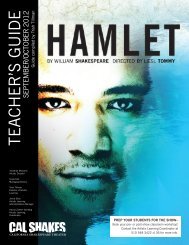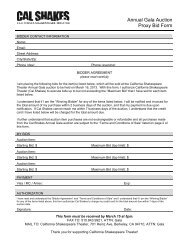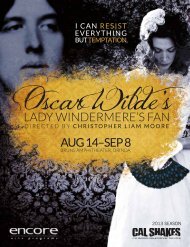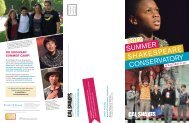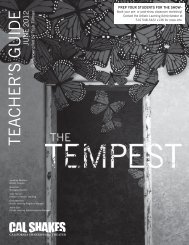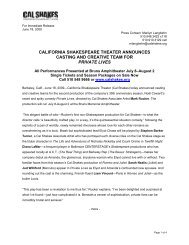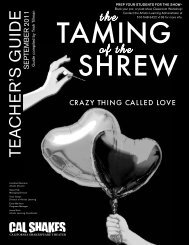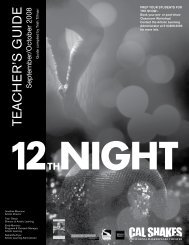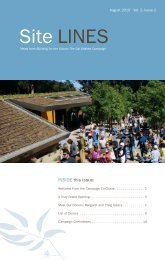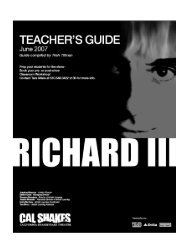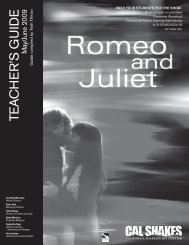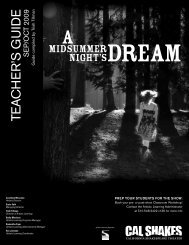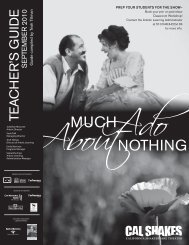Read Spunk Program - California Shakespeare Theater
Read Spunk Program - California Shakespeare Theater
Read Spunk Program - California Shakespeare Theater
Create successful ePaper yourself
Turn your PDF publications into a flip-book with our unique Google optimized e-Paper software.
PHOTO BY KEVIN BERNE<br />
FROM THE ARTISTIC DIRECTOR<br />
The fi rst time I experienced <strong>Spunk</strong> was in 1989 at the Public <strong>Theater</strong> in New<br />
York. I had been working for Joe Papp for almost three years, and had watched<br />
George C. Wolfe’s previous piece, the brilliant Colored Museum, nearly 20 times.<br />
Brazenly irreverent, blazingly theatrical, fi ercely funny, and sharp like a knife, The<br />
Colored Museum remains one of the highlights of my theatergoing history. <strong>Spunk</strong><br />
is all that without the irreverence. George C. Wolfe is a big personality, but even<br />
he knew that Zora Neale Hurston was due for her time in the contemporary cultural spotlight.<br />
It wasn’t until years later that I learned how Hurston rose to divine prominence during the Harlem<br />
Renaissance and beyond, only to have her creative legacy nearly obliterated over the years by many who<br />
found her work to be, at the very least, reactionary. But when scholars and writers—Alice Walker among<br />
them—brought her back into our cultural consciousness in the mid-to-late-1970s, it was just a matter<br />
of time before Wolfe, one of our greatest living and most daring theatrical artists, would “team up” with<br />
Hurston, one of America’s most thrilling, trailblazing artists of the 20th century—or any century, for that<br />
matter. And so, in 1989, we got <strong>Spunk</strong>.<br />
What a play, I thought. Poetry in motion. Blending folklore with sass, heartbreak with celebration,<br />
literature with theater, George C. Wolfe created something indelible and rare—a piece that felt like a<br />
classic while at the same time forging new and adventurous terrain in the theatrical landscape. I’m so<br />
glad I thought of <strong>Spunk</strong> to bring to Cal Shakes. It thrilled me like Nicholas Nickleby did when the Royal<br />
<strong>Shakespeare</strong> Company brought the sprawling brilliance of their Dickensian adaptation to the stage in<br />
the 1980s. This is storytelling at its jazziest, its sexiest, its most shrewdly-observed humanness. There<br />
is hurt in this play; there is love; and there is laughter. But most of all, there is music. And not just the<br />
music that is sung, but the music that is spoken, the music of Zora Neale Hurston, who heard, with<br />
the most delicate and unforgiving ear, the way the world spoke to her about loving and hurting and<br />
laughing—that is, about being alive.<br />
We are celebrating a lot with this production. It’s a fi rst for us in many ways, not the least of which is<br />
that we are bringing a lot of voices into this house that have not been included before. And there’s going<br />
to be a lot more of that, because Cal Shakes should, and will, belong to as many people as we can invite,<br />
engage, and participate with—on our stage, in our classrooms, and in our communities.<br />
If you rode the shuttle from BART you heard some contemporary blues music. Along the entrance path,<br />
in the plaza, on the hill, at listening stations, and, of course, onstage, we have fi lled the joint with art.<br />
Our <strong>Theater</strong> is vast in scope—literally and creatively. So there will never be enough art to fi ll our space.<br />
This production is part of an experiment to increase participation among more artists, more students,<br />
and more community members. I look to places like the Oakland Museum of <strong>California</strong>, where everything<br />
and everyone lives in dynamic conversation with one another, and I hope for the same at Cal Shakes. All<br />
these experiments might result in something truly beautiful and truly necessary: a culture in which art<br />
and communities are inseparable, and where the joint is truly and undeniably alive.<br />
Welcome to <strong>Spunk</strong>.<br />
Jonathan Moscone<br />
encoreartsprograms.com 5



